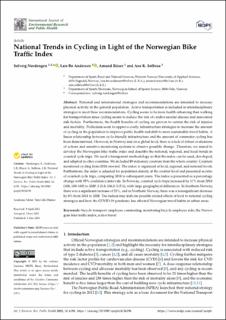National trends in cycling in light of the Norwegian bike traffic index
Peer reviewed, Journal article
Published version
Permanent lenke
https://hdl.handle.net/11250/2833710Utgivelsesdato
2021Metadata
Vis full innførselSamlinger
- Artikler / Articles [2096]
- Publikasjoner fra Cristin [1084]
Originalversjon
International Journal of Environmental Research and Public Health. 2021, 18(12), Artikkel 6198. 10.3390/ijerph18126198Sammendrag
National and international strategies and recommendations are intended to increase physical activity in the general population. Active transportation is included in interdisciplinary strategies to meet these recommendations. Cycling seems to be more health enhancing than walking for transportation since cycling seems to reduce the risk of cardiovascular disease and associated risk factors. Furthermore, the health benefits of cycling are proven to outrun the risk of injuries and mortality. Politicians seem to approve costly infrastructure strategies to increase the amount of cycling in the population to improve public health and shift to more sustainable travel habits. A linear relationship between cycle-friendly infrastructure and the amount of commuter cycling has been demonstrated. However, in Norway and on a global level, there is a lack of robust evaluations of actions and sensitive monitoring systems to observe possible change. Therefore, we aimed to develop the Norwegian bike traffic index and describe the national, regional, and local trends in counted cycle trips. We used a transparent methodology so that the index can be used, developed, and adapted in other countries. We included 89 stationary counters from the whole country. Counters monitored cycling from 2018 onward. The index is organized at local, regional, and national levels. Furthermore, the index is adjusted for population density at the counter level and presented as ratio of counted cycle trips, comparing 2018 to subsequent years. The index is presented as a percentage change with 95% confidence intervals. In Norway, counted cycle trips increased by 11% from 2018 (100, 100–100) to 2020 (111.0, 106.2–115.1), with large geographical differences. In Southern Norway, there was a significant increase of 23%, and in Northern Norway, there was a nonsignificant decrease by 8% from 2018 to 2020. The indices may indicate possible related effects of local to national cycling strategies and how the COVID-19 pandemic has affected Norwegian travel habits in urban areas.
Beskrivelse
This article is an open access article distributed under the terms and conditions of the Creative Commons Attribution (CC BY) license (https://creativecommons.org/licenses/by/4.0/).
